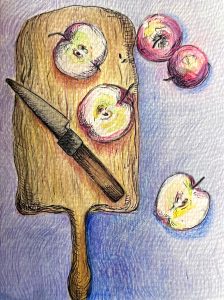At home in the North Cascades
By Kavya Pradhan
Needles, needles, and some more needles. That is what I am left with after the summer and while meticulously measuring and weighting and drying E-V-E-R-Y S-I-N-G-L-E O-N-E isn’t always the most fun thing to do, I had lots of fun collecting them.
We would head out every week from Seattle with a car packed with all the supplies and field gear we needed for the upcoming week or so and drive a few hours to campsites that ended up feeling like home by the end of the summer. The goal here was to characterize community composition (what plant species are there?) and get some information on traits (mostly related to photosynthesis) for conifers in our sites.
Armed with backpacks filled with field-gear, our trusty field-guides, and the never-ending hope that this day will be a day without rain, we did a combination of driving, hiking, and bush-wacking to our sites while pausing to admire all the plants we could possibly identify. It was just so much fun to be able to nerd-out with some fellow plant enthusiasts, aka, our brilliant field crew. Once at a site, we spent a good amount of time ID-ing even more plants and getting a sense of the community composition there (we of course did this following a strict protocol, but I won’t bore you with the details). And then the real fun began…
Turns out if you are interested in conifer photosynthetic traits, you need to get your hands on conifer needles that are pretty high up on the tree (where needles have sufficient sun exposure and are photosynthetically active). While I could have learned to climb trees (a dangerous skill to learn so quickly) or learned to use a shotgun (seriously, some researchers do shoot trees to get their leaves), I instead chose to invest my time and energy into a giant slingshot (officially referred to as an arborist’s throwline launcher, but calling it a giant sling shot is so much more fun!) and saw the branches down. And after lots of trial and error and some more error, it worked! As an added bonus, sling-shooting a 16oz weight at a tree branch about 35-40 ft high and then successfully sawing the branch off was incredibly empowering.
We spent most of our days picking out the perfect trees and sawing down some amazing branches. We then got in-field photosynthetic data using a very useful handled device called a MultispeQ and wrapped up selected samples for more processing in the lab. Then pack up for the week just to do it all over again.
Summer was a whirlwind of going back and forth from Seattle to the North Cascades, scrambling to collect gear and equipment, modifying protocols, and making sure my precious conifer needle samples were safe and sound. Although it was extremely stressful, I can’t wait to do it all over again. After all, who could argue with calling the great outdoors their office space?
Kavya is a 4th year PhD student in Janneke Hille Ris Lamber’s lab.


